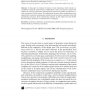104 search results - page 9 / 21 » Globally Asynchronous Locally Synchronous FPGA Architectures |
DAC
1999
ACM
13 years 11 months ago
1999
ACM
Retiming is an optimization technique for synchronous circuits introduced by Leiserson and Saxe in 1983. Although powerful, retiming is not very widely used because it does not ha...
CL
2010
Springer
13 years 7 months ago
2010
Springer
In this paper we present the syntax, semantics, and compilation of a new system-level programming language called SystemJ. SystemJ is a multiclock language supporting the Globally...
FPGA
2006
ACM
13 years 11 months ago
2006
ACM
This paper examines the tradeoffs between flexibility, area, and power dissipation of programmable clock networks for FieldProgrammable Gate Arrays (FPGA's). The paper begins...
TPDS
2002
13 years 7 months ago
2002
This paper considers a technique for composing global (barrier-style) and local (channel scanning) synchronization protocols within a single parallel discrete-event simulation. Com...
ACSD
2004
IEEE
13 years 11 months ago
2004
IEEE
In this paper we introduce the notion of weak endochrony, which extends to a synchronous setting the classical theory of Mazurkiewicz traces. The notion is useful in the synthesis ...

